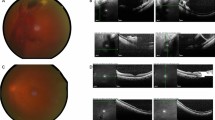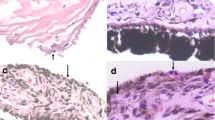Abstract
Background
To evaluate the capability of adjuvant intraocular ranibizumab (Lucentis®) injections in the treatment of rubeosis and intraocular pressure in patients with rubeosis and neovascular glaucoma.
Methods
Ten eyes with rubeosis (R) and ten eyes with neovascular glaucoma (NVG) received Lucentis® injections (ranibizumab 0.5 mg/0.05 ml) in this prospective, monocenter, 12-months, interventional case series. The primary efficacy outcome measure was the change of degree of iris rubeosis as documented by iris fluorescein angiography measured after 12 months. Secondary outcomes were intraocular pressure (IOP), best-corrected visual acuity (BCVA, logMAR), numbers of additional interventions or antiglaucoma medications administered after injection, the gonioscopic status of the anterior chamber angle, and central retinal thickness.
Results
In the R group, 3.6 injections and in the NVG group 2.3 injections of Lucentis® were administered. Additional treatments were photocoagulation (n = 19), cyclodestructive procedures (n = 9), cryopexy (n = 3), and vitrectomy (n = 1). The mean stage of rubeosis was 3.4 ± 0.7 in the R group and 3.6 ± 0.8 in the NVG group at baseline. At month 12, the rubeosis was almost resolved in the R group (0.1 ± 0.3, p < 0.001), and decreased significantly in the NVG group (0.7 ± 1.1, p < 0.001). In the NVG subgroup, mean IOP was 41.4 ± 13.4 mmHg at baseline, which decreased rapidly (18.2 ± 12.3, day-14, p = 0.005) and stabilized during the follow-up (15.6 ± 2.0 mmHg, p < 0.05). BCVA improved significantly in both groups (p < 0.05, at month 12).
Conclusions
Injection of 0.5 mg ranibizumab appears to be beneficial as an adjuvant treatment in neovascular glaucoma and rubeosis due to its anti-angiogenic properties and its ability to prevent establishment or progression of anterior chamber angle obstruction. Conventional therapeutic procedures addressing the retinal ischemia are still required in a stage-wise treatment approach.







Similar content being viewed by others
References
Avery RL (2006) Regression of retinal and iris neovascularization after intravitreal bevacizumab (Avastin) treatment. Retina 26:352–354
Davidorf FH, Mouser JG, Derick RJ (2006) Rapid improvement of rubeosis iridis from a single bevacizumab (Avastin) injection. Retina 26:354–356
Grisanti S, Biester S, Peters S, Tatar O, Ziemssen F, Bartz-Schmidt KU, Tuebingen Bevacizumab Study Group (2006) Intracameral bevacizumab for iris rubeosis. Am J Ophthalmol 142:158–160
Iliev ME, Domig D, Wolf-Schnurrbursch U, Wolf S, Sarra GM (2006) Intravitreal bevacizumab (Avastin) in the treatment of neovascular glaucoma. Am J Ophthalmol 142:1054–1056
Kahook MY, Schuman JS, Noecker RJ (2006) Intravitreal bevacizumab in a patient with neovascular glaucoma. Ophthalmic Surg Lasers Imaging 37:144–146
Mason JO 3rd, Albert MA Jr, Mays A, Vail R (2006) Regression of neovascular iris vessels by intravitreal injection of bevacizumab. Retina 26:839–841
Silva Paula J, Jorge R, Alves Costa R, Rodrigues Mde L, Scott IU (2006) Short-term results of intravitreal bevacizumab (Avastin) on anterior segment neovascularization in neovascular glaucoma. Acta Ophthalmol Scand 84:556–557
Ferrara N, Hillan KJ, Gerber HP, Novotny W (2004) Discovery and development of bevacizumab, an anti-VEGF antibody for treating cancer. Nat Rev Drug Discov 3:391–400
Massin P, Bandello F, Garweg JG, Hansen LL, Harding SP, Larsen M, Mitchell P, Sharp D, Wolf-Schnurrbusch UE, Gekkieva M, Weichselberger A, Wolf S (2010) Safety and efficacy of ranibizumab in diabetic macular edema (RESOLVE Study): a 12-month, ranodmized, controlled, double-masked, multicenter phase II study. Diabetes Care 33:2399–2405
Mitchell P, Bandello F, Schmidt-Erfurth U, Lang GE, Massin P, Schlingemann RO, Sutter F, Simader C, Burian G, Gerstner O, Weichselberger A, RESTORE study group (2011) The RESTORE study: ranibizumab monotherapy or combined with laser versus laser monotherapy for diabetic macular edema. Ophthalmology 118:615–662
Brown DM, Campochiaro PA, Singh RP, Li Z, Gray S, Saroj N, Rundle AC, Rubio RG, Murahashi WY, CRUISE Investigators (2010) Ranibizumab for macular edema following central retinal vein occlusion: six-month primary end point results of a phase III study. Ophthalmology 117:1124–1133
Ehrenberg M, McCuen BW 2nd, Schindler RH, Machemer R (1984) Rubeosis iridis: preoperative iris fluorescein angiography and periocular steroids. Ophthalmology 91:321–325
Jaissle GB, Szurman P, Bartz-Schmidt KU (2005) [Recommendation for the implementation fo intravitreal injections—statement of the German Retina Society of Ophthalmology (DOG) and the German Professional Association of Ophthalmologists (BVA). Klin Monatsbl Augenheilkd 222:390–395
Campochiaro PA, Heier JS, Feiner L, Gray S, Saroj N, Rundle AC, Murahashi WY, Rubio RG, BRAVO Investigators (2010) Ranibizumab for macular edema following branch retinal vein occlusion: six-month primary end point results of a phase III study. Ophthalmology 117:1102–1112
Wakabayashi T, Oshima Y, Sakaguchi H, Ikuno Y, Miki A, Gomi F, Otori Y, Kamei M, Kusaka S, Tano Y (2008) Intravitreal bevacizumab to treat iris neovascularization and neovascular glaucoma secondary to ischemic retinal diseases in 41 consecutive cases. Ophthalmology 115:1571–1580
Yazdani S, Hendi K, Pakravan M (2007) Intravitreal bevacizumab (Avastin) injection for neovascular glaucoma. J Glaucoma 16:437–439
Ehlers JP, Spirn MJ, Lam A, Sivalingam A, Samuel MA, Tasman W (2008) Combination intravitreal bevacizumab/panretinal photocoagulation versus panretinal photocoagulation alone in the treatment of neovascular glaucoma. Retina 28:696–702
Spaide RF, Chang LK, Klancnik JM, Yannuzzi LA, Sorenson J, Slakter JS, Freund KB, Klein R (2009) Prospective study of intravitreal ranibizumab as a treatment for decreased visual acuity secondary to central retinal vein occlusion. Am J Ophthalmol 147:298–306
Kinge B, Stordahl PB, Forsaa V, Fossen K, Haugstad M, Helgesen OH, Seland J, Stene-Johansen I (2010) Efficacy of ranibizumab in patients with macular edema secondary to central retinale vein occlusion: results from the sham-controlled ROCC study. Am J Ophthalmol 150:310–314
Abraham P, Yue H, Wilson L (2010) Randomized, double-masked, sham-controlled trial of ranibizumab for neovascular age-related macular degeneration: PIER study year 2. Am J Ophthalmol 150:315–324
Campochiaro PA, Hadiz G, Channa R, Shah SM, Nguyen QD, Ying H, Do DV, Zimmer-Galler I, Solomon SD, Sung JU, Syed B (2010) Antagonism of vascular endothelial growth factor for macular edema caused by retinal vein occlusions: two-year outcomes. Ophthalmology 117:2387–2394
Ishida S, Usui T, Yamashiro K, Kaji Y, Amano S, Ogura Y, Hida T, Oguchi Y, Ambati J, Miller JW, Gragoudas ES, Ng YS, D’Amore PA, Shima DT, Adamis AP (2003) VEGF164-mediated inflammation is required for pathological, but not physiological, ischemia-induced retinal neovascularization. J Exp Med 198:483–489
Inan UU, Avci B, Kusbeci T, Kaderli B, Avci R, Temel SG (2007) Preclinical evaluation of intravitreal injection of full-length humanized vascular endothelial growth factor antibody in rabbit eyes. Invest Ophthalmol Vis Sci 48:1773–1781
Martin DF, Maguire MG, Fine SL, Fine SL, Ying GS, Jaffe GJ, Grunwald JE, Toth C, Redford M, Ferris FL 3rd (2012) Comparison of age-related macular degeneration treatments trials (CATT) research group writing committee: ranibizumab and bevacizumab for treatment of neovascular age-related macular degeneration: two-year results. Ophthalmology 119:1388–1398
Conflict of interest
No conflicting relationship exists for any author.
Financial support
Novartis Pharma GmbH. The sponsor had no role in the design or conduct of this research.
Author information
Authors and Affiliations
Corresponding author
Additional information
Matthias Lüke and Salvatore Grisanti contributed equally to the work, and should be considered equivalent senior authors.
Clinical Trials registration number: NCT01370135
Presented on DOG 2011 (SA57-356)
The authors have full control of all primary data, and they agree to allow Graefe’s Archive for Clinical and Experimental Ophthalmology to review their data upon request.
Rights and permissions
About this article
Cite this article
Lüke, J., Nassar, K., Lüke, M. et al. Ranibizumab as adjuvant in the treatment of rubeosis iridis and neovascular glaucoma—results from a prospective interventional case series. Graefes Arch Clin Exp Ophthalmol 251, 2403–2413 (2013). https://doi.org/10.1007/s00417-013-2428-y
Received:
Revised:
Accepted:
Published:
Issue Date:
DOI: https://doi.org/10.1007/s00417-013-2428-y




